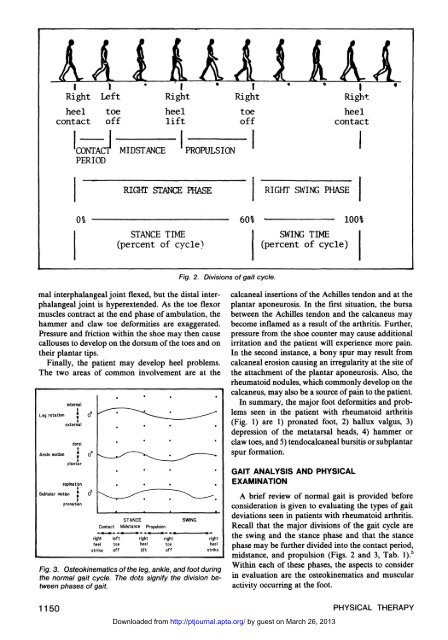Pathomechanics, Gait Deviations, and Treatment ... - Physical Therapy
Pathomechanics, Gait Deviations, and Treatment ... - Physical Therapy
Pathomechanics, Gait Deviations, and Treatment ... - Physical Therapy
You also want an ePaper? Increase the reach of your titles
YUMPU automatically turns print PDFs into web optimized ePapers that Google loves.
mal interphalangeal joint flexed, but the distal interphalangeal<br />
joint is hyperextended. As the toe flexor<br />
muscles contract at the end phase of ambulation, the<br />
hammer <strong>and</strong> claw toe deformities are exaggerated.<br />
Pressure <strong>and</strong> friction within the shoe may then cause<br />
callouses to develop on the dorsum of the toes <strong>and</strong> on<br />
their plantar tips.<br />
Finally, the patient may develop heel problems.<br />
The two areas of common involvement are at the<br />
Fig. 3. Osteokinematics of the leg, ankle, <strong>and</strong> foot during<br />
the normal gait cycle. The dots signify the division between<br />
phases of gait<br />
1150<br />
Fig. 2. Divisions of gait cycle.<br />
calcaneal insertions of the Achilles tendon <strong>and</strong> at the<br />
plantar aponeurosis. In the first situation, the bursa<br />
between the Achilles tendon <strong>and</strong> the calcaneus may<br />
become inflamed as a result of the arthritis. Further,<br />
pressure from the shoe counter may cause additional<br />
irritation <strong>and</strong> the patient will experience more pain.<br />
In the second instance, a bony spur may result from<br />
calcaneal erosion causing an irregularity at the site of<br />
the attachment of the plantar aponeurosis. Also, the<br />
rheumatoid nodules, which commonly develop on the<br />
calcaneus, may also be a source of pain to the patient.<br />
In summary, the major foot deformities <strong>and</strong> problems<br />
seen in the patient with rheumatoid arthritis<br />
(Fig. 1) are 1) pronated foot, 2) hallux valgus, 3)<br />
depression of the metatarsal heads, 4) hammer or<br />
claw toes, <strong>and</strong> 5) tendocalcaneal bursitis or subplantar<br />
spur formation.<br />
GAIT ANALYSIS AND PHYSICAL<br />
EXAMINATION<br />
A brief review of normal gait is provided before<br />
consideration is given to evaluating the types of gait<br />
deviations seen in patients with rheumatoid arthritis.<br />
Recall that the major divisions of the gait cycle are<br />
the swing <strong>and</strong> the stance phase <strong>and</strong> that the stance<br />
phase may be further divided into the contact period,<br />
midstance, <strong>and</strong> propulsion (Figs. 2 <strong>and</strong> 3, Tab. 1). 5<br />
Within each of these phases, the aspects to consider<br />
in evaluation are the osteokinematics <strong>and</strong> muscular<br />
activity occurring at the foot.<br />
Downloaded from<br />
http://ptjournal.apta.org/ by guest on March 26, 2013<br />
PHYSICAL THERAPY
















